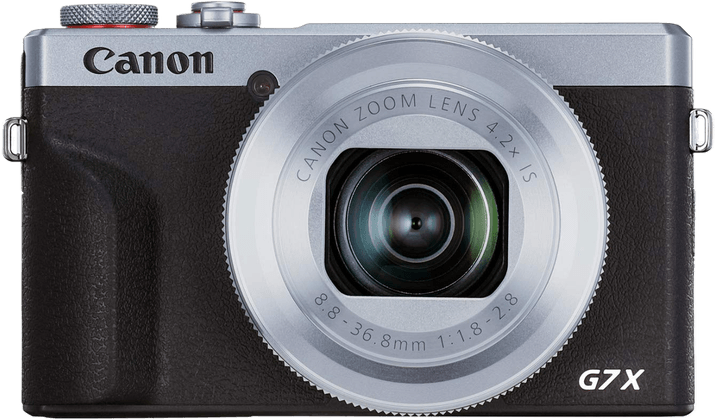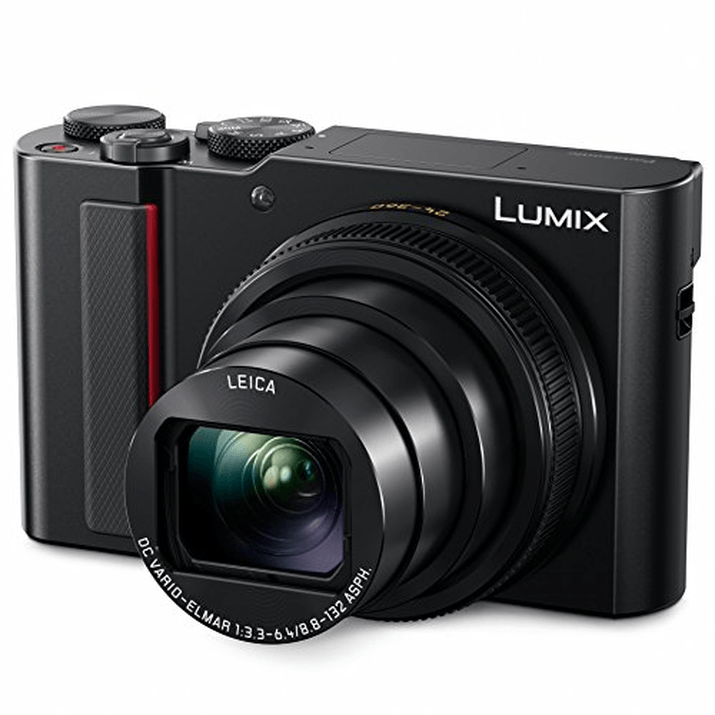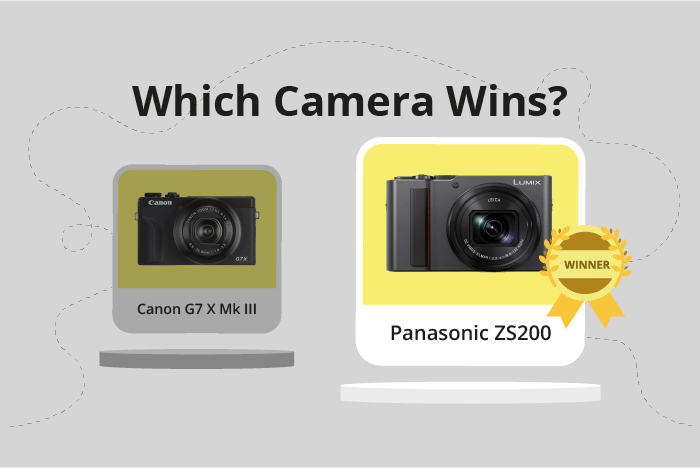Canon PowerShot G7 X Mark III vs Panasonic Lumix ZS200 (TZ200) Comparison
Canon PowerShot G7 X Mark III

Panasonic Lumix ZS200 / TZ200

The Panasonic Lumix ZS200 (TZ200) comes out ahead with a score of 62/100, while the Canon PowerShot G7 X Mark III trails slightly behind at 59/100. Both cameras are compact and were released in 2018 and 2019, respectively. They share similarities in size, with the Lumix ZS200 measuring 111 x 66 x 45mm and the PowerShot G7 X Mark III at 105 x 61 x 41mm.
The Lumix ZS200 gains an edge due to its higher score, which means it is a better camera. On the other hand, the PowerShot G7 X Mark III is lighter, weighing 304g compared to the Lumix ZS200’s 340g, offering users a more portable option. However, the Lumix ZS200’s launch price is higher at $799, while the PowerShot G7 X Mark III is more affordable at $749.
Taking these factors into consideration, the Panasonic Lumix ZS200 (TZ200) is a better camera overall, but the Canon PowerShot G7 X Mark III offers a more budget-friendly and lightweight alternative.
Canon PowerShot G7 X Mark III vs Panasonic Lumix ZS200 (TZ200) Overview and Optics
The Panasonic Lumix ZS200 (TZ200) emerges as the winner in our optics comparison, scoring 61/100, while the Canon PowerShot G7 X Mark III trails behind with a score of 57/100. Both cameras share common specifications such as 20-megapixel resolution, CMOS sensor type, 1″ sensor size, fixed lens mount, and image stabilization.
The Lumix ZS200 outperforms the PowerShot G7 X Mark III in two key areas. Firstly, it has a higher DXOMARK sensor score of 71, compared to the G7 X Mark III’s 58. This means the Lumix ZS200’s sensor provides better image quality and performance. Secondly, the ZS200 is equipped with the Venus Engine processor which contributes to its superior image processing capabilities.
On the other hand, the Canon PowerShot G7 X Mark III boasts a faster shooting speed of 30, compared to the Lumix ZS200’s 10. This advantage allows the G7 X Mark III to capture images more quickly, making it a better choice for action photography or fast-paced situations.
Taking these factors into account, the Panasonic Lumix ZS200 (TZ200) is a better choice for those who prioritize image quality and processing capabilities. However, if speed is a crucial factor, the Canon PowerShot G7 X Mark III may be a more suitable option due to its faster shooting capabilities. Ultimately, the choice between these two cameras largely depends on the specific needs and preferences of the photographer.
Canon PowerShot G7 X Mark III vs Panasonic Lumix ZS200 (TZ200) Video Performance
The Canon PowerShot G7 X Mark III emerges as the winner in the video capabilities comparison, scoring 91 out of 100, while the Panasonic Lumix ZS200 (TZ200) scores 83. Both cameras share some common video specifications, such as 4K max video resolution and dimensions of 3840 x 2160. Additionally, both cameras have built-in time-lapse functionality.
The Canon PowerShot G7 X Mark III outperforms the Panasonic Lumix ZS200 in video frame rate, offering a maximum of 120fps as opposed to the Lumix ZS200’s 60fps. This higher frame rate allows the G7 X Mark III to capture smoother, more detailed video, particularly in fast-action scenes or slow-motion playback.
While the Lumix ZS200 does not surpass the G7 X Mark III in any specific video specification, it still delivers impressive video quality with its 4K resolution and built-in time-lapse functionality. The Lumix ZS200 remains a strong contender in the compact camera market, but it falls behind the G7 X Mark III in terms of video capabilities.
Taking into account the video specifications and performance, the Canon PowerShot G7 X Mark III stands out as the superior camera for videographers. Its higher frame rate of 120fps offers users the ability to capture smoother, more detailed videos than the Panasonic Lumix ZS200. However, the Lumix ZS200 still provides quality video performance and should not be dismissed entirely. Ultimately, the choice between these two cameras will depend on the user’s specific needs and preferences, with the G7 X Mark III being the clear choice for those prioritizing video capabilities.
Canon PowerShot G7 X Mark III vs Panasonic Lumix ZS200 (TZ200) Features and Benefits
The Canon PowerShot G7 X Mark III and the Panasonic Lumix ZS200 (TZ200) both have a feature score of 70/100, making them evenly matched in this aspect. They share several specifications, including a 3-inch screen size, touchscreen functionality, WiFi and Bluetooth connectivity, and the absence of GPS.
The Canon PowerShot G7 X Mark III has an advantage in its flip screen feature, which allows for more flexible shooting angles and is particularly useful for vlogging or taking selfies. This feature is not present in the Panasonic Lumix ZS200 (TZ200).
On the other hand, the Panasonic Lumix ZS200 (TZ200) has a higher screen resolution of 1,240,000 dots, compared to the Canon PowerShot G7 X Mark III’s 1,040,000 dots. This higher resolution provides a clearer and more detailed image preview when composing and reviewing shots. However, this advantage may not be significant enough to sway users who prioritize the flip screen functionality.
In conclusion, the Canon PowerShot G7 X Mark III and the Panasonic Lumix ZS200 (TZ200) have similar feature scores and specifications. The deciding factor for potential buyers may depend on their specific needs and preferences. Those who value a flip screen for various shooting angles and convenience may lean towards the Canon PowerShot G7 X Mark III, while those who prioritize a higher screen resolution for better image preview might prefer the Panasonic Lumix ZS200 (TZ200).
Canon PowerShot G7 X Mark III vs Panasonic Lumix ZS200 (TZ200) Storage and Battery
The Panasonic Lumix ZS200 (TZ200) outperforms the Canon PowerShot G7 X Mark III in the storage and battery category, scoring 35 out of 100, while the Canon scores only 27. Both cameras have one memory card slot and accept SD, SDHC, and SDXC (UHS-I compatible) memory cards. They also both support USB charging.
The Lumix ZS200 excels with its longer battery life, providing 370 shots per charge, compared to the PowerShot G7 X Mark III’s 235 shots. This significant difference makes the Lumix ZS200 more suitable for extended photography sessions.
The Canon PowerShot G7 X Mark III does not offer any advantages over the Panasonic Lumix ZS200 in this category. The Lumix ZS200’s superior battery life makes it the better choice for those prioritizing extended shooting capabilities and storage.
Canon PowerShot G7 X Mark III vs Panasonic Lumix ZS200 (TZ200) – Our Verdict
Are you still undecided about which camera is right for you? Have a look at these popular comparisons that feature the Canon PowerShot G7 X Mark III or the Panasonic Lumix ZS200 (TZ200):
- Panasonic Lumix DMC ZS100 vs Lumix ZS200 (TZ200)
- Canon PowerShot G7 X Mark III vs Sony Cyber-shot DSC-RX100 VII
- Canon PowerShot G7 X Mark II vs PowerShot G7 X Mark III
- Panasonic Lumix ZS200 (TZ200) vs Sony Cyber-shot DSC-RX100 VII
- Canon PowerShot G5 X Mark II vs PowerShot G7 X Mark III
- Canon PowerShot G7 X Mark III vs Ricoh GR IIIx

